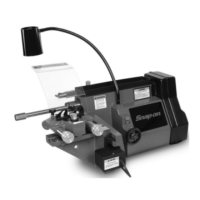Snap-on • 15
Spindle Timing Belt Replacement
Note: Replace the timing belts in pairs only.
1. Disconnect the lathe from the power source.
2. Remove the two (2) screws and washers secur-
ing the drive belt cover and remove the cover.
3. Remove the nuts and washers from the studs
supporting the idler bracket. Loosen the lock nut of the
idler bracket tension screw, and completely back off
the idler tension screw. Slide the idler bracket off the
studs and the pulleys out of the timing belts.
4. Hang the new timing belts on the spindle pulleys
and replace the idler bracket assembly. Lift the idler
bracket to slide the timing belts onto the idler pulleys.
5. Replace the washers and nuts on the idler bracket
studs. Use a wrench to tighten the nuts, then back the
nuts off 1/4 to 1/2 turn. Adjust the timing belt tension
as described in SPINDLE TIMING BELT ADJUSTMENT.
6. Install the drive belt cover and secure it with two
(2) screws and washers.
Spindle Timing Belt Adjustment
1. Disconnect the lathe from the power source.
2. Remove the two (2) screws and washers secur-
ing the drive belt cover and remove the cover.
3. Determine which timing belt is the tighter of the
two. Use the tighter belt to set the tension for both
timing belts.
4. Loosen the two (2) nuts securing the jack shaft
support to the main frame.
5. Loosen the lock nut of the adjustment screw on
the under side of the jack shaft support. Turn the screw
to adjust the timing belt tension so it can be deflected
1/8" to 1/4" by pressing against the left side of the belt
between the jack shaft and the spindle.
6. When the tension is set, tighten the lock adjust-
ment screw lock nut and then the jack shaft support
screws.
7. Replace the yoke cover and secure it with the nut.
Tool Bar Adjustment
1. Turn the micrometer dial counterclockwise to
unscrew the dial from the boring bar. Remove the
micrometer dial assembly.
2. Unscrew the two (2) allen head cap screws from
the tool holder end of the tool bar. Press the tool
holder against a solid stop, pull the screws from the
boring bar and carefully ease the bar away from the
stop.
3. Clean all metal chips and dirty grease from all the
working parts.
4. Slip the spring into the bore of the tool bar.
Grease the sleeve with white grease and slip it into the
bore of the tool bar.
5. Slip the tool holder between the ears of the bor-
ing bar, press the tool holder against a solid stop and
insert the allen head cap screws. Run the screws all
the way in.
7. Fully tighten one of the allen head cap screws,
then back the micrometer dial out two turns.
8. Slowly loosen the allen head cap screw until the
tool holder slips back.
9. Screw the micrometer all the way in and repeat
steps 7 and 8 for the other allen head cap screw.
Gib Adjustment
1. Loosen the eight (8) cap screws (part #906353)
on the vertical face of the slide and loosen the four (4)
button head screws (part #924759) on the end plate
(925772). This allows the lead screw to float in hori-
zontal and vertical directions to insure that the gib
tightens across the dovetail, not the lead screw.
2. Tighten the three (3) gib set screws (part
#925786) then back off each screw 1/4 turn.
3. Tighten the middle screw while moving the edge
of the slide farthest from the machine in an up-and-
down motion. Tighten only until vertical motion is elim-
inated. If more than slight resistance is felt while
turning the handwheel, the screw is too tight.
4. Tighten the remaining two (2) gib screws sepa-
rately, while turning the handwheel to move the slide
back and forth on the ways. Tighten until only slight
resistance is felt as the handwheel is turned.
5. Turn the lathe ON. Run the slide all the way to the
end of its travel (away from the arbor). While exerting
slight pressure on the handwheel in the direction of
the end-stop, tighten the four (4) cap screws in the ver-
tical face of the slide, opposite the motor. This insures
perpendicularity between the end plate and the ways.
6.Tighten the four (4) button head screws in the end
plate. This centers the lead screw.
7. Run the slide all the way in (to the arbor). Tighten
the four (4) cap screws on the vertical face of the slide,
next to the motor. This centers the motor.
8. If a “clicking” sound is heard, loosen the four (4)
cap screws on the motor vertically. When the sound
stops, tighten the screws. Clicking is heard when the
leadscrew/coupling is not running at a constant veloc-
ity. Centering the motor eliminates that problem.
Brake Lathes

